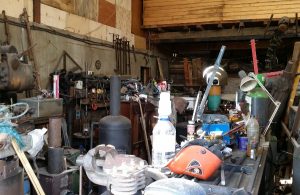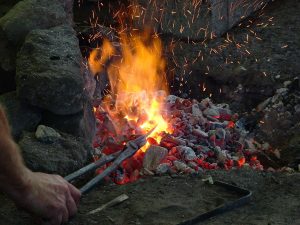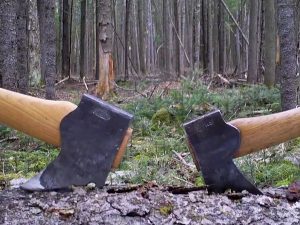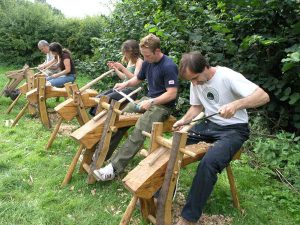Standing outside Huddiksval train station, it’s pouring with rain and I am beginning to wonder what the hell I am doing here. Having been travelling for 12 hours I’m tired and hungry, there is no one here to collect me, a taxi is more expensive than my flight from the UK and not a bus in sight …….
However, it turns out the blacksmithing gods are looking down on me – a single bus pulls up, it’s the only one running on Sunday and by some small chance it just happens to be going to Gransfors Burks! I think it’s going to be ok.
The idea of attending the axe making course at Gransfors came some years ago after reading Lars Enanders book Swedish Blacksmithing. There is a small ad at the back describing the axe factory and the possibility of doing a course – I was hooked! However it wasn’t for another 4 years could I find the time and money, to head to Sweden and see this iconic place for myself.
Sunday night, August 2014, I am carrying a small tool box of essentials, a kit bag and accompanied by a young American smith, Sam Ritter, who I met on the bus. The whole area is totally deserted as we walk into the small settlement of Gransfors – there in front of us are the axe factory and shop, the axe museum, the pottery factory and a small café/guesthouse all situated by a beautiful, fast flowing river. It’s misty, it’s deserted and all we can hear is the river – think Deliverance (just without the banjo).

Monday morning and the fun begins. The courses are run from a very well equipped workshop attached to the side of the main factory, there are 8 students in total along with Fredrik Thelin who will be teaching us (in both Swedish and English I am glad to hear) and his apprentice Abu. We are a mixed bunch – 1 Aussie, 1 American, 1 Swiss, 2 Germans, 2 Swedes and 1 Brit – and are first given a full tour of the factory.
Awesome is what comes to mind! Just 2 of the press hammers are in action that morning but the noise is something else and it is a privilege to see these extremely skilled smiths working these monsters. I stand watching the oldest employee making the smallest axes that Gransfors produces and it’s like watching a dance – smooth actions, total confidence and stunning rhythm. This guy has been at the factory for over 40 years and has total control of his material and tools – one of the simple reasons that this place makes some of the best axes in the world.
Gransfors Bruks AV was established in around 1900 (?) and is situated 350 km north of Stockholm. It has been synonymous with the highest quality edge tools for many years and currently 80% of their production is exported to over 22 countries. An average of 85,000 perfect axes are produced every year and each one is signed with the smith’s initials – there is no room for error and the scrap skips are piled high with axe heads that didn’t make the grade ! A great place for a bin rummage ……….

One of the aspects that struck me most was not just the quality of the product produced but the way in which it is produced . “We have a responsibility for the total” is the code by which they run their business – “working conditions, product quality and concern for nature are parts of the total; humanity and ethics are equally as important”. How refreshing to see a business hand making things, making a profit, a good living for its workers and doing it with an ethical and aware attitude.
‘To make a high quality product is a way to pay respect and be responsible to the user………..: Increased durability means that we take less (decreased consumption of material and energy), that we need to produce less …… and destroy less (less waste).
After the tour we get to work. The first two days are spent forging chisels (DON) that we will use to make the axe eyes – heavy gauge axe steel is tough and although there are two beautiful Bahco spring hammers we are told that these are off limits at the moment. Hard work even for a full-time smith but I am working next to Lars, from Germany , who has never forged before, ever! What an inspiration he turns out to be – no complaining, no slacking off, nothing is too hard and he produces work worthy of someone with a great deal of skill. A truly humbling experience.
Next comes a splitting axe (KLYV YXA) , which provides much needed practice for later, followed by tongs (TANGER). These I enjoy making a great deal – 25 mm round mild steel, single piece and again hand forged – and as I never seem to have enough time during an average working week to make new tongs this was a pleasure. There is something extremely satisfying about making the right tool for a specific job.

Friday and time to work on some knife making – a single piece knife (KNIVAR) and a half tang laminate knife (VALLA). Having made dozens of single piece foraging (or bush craft) knives at home this is a chance to explore some new styles and especially new materials. The workshop storeroom is stacked with a huge variety of tool steels, axe steels, blade steels and many others of unknown origin and being let loose in there is great. Having hammered out half a dozen blades I turn to making the laminate blade.
We are using the method demonstrated in Lars book which involves folding a piece of 4 x 20 mm mild steel back on itself to create a springy ‘pinch’ into which a thin piece of edge steel is inserted. This is then fluxed and forge welded to create the laminate. Easy enough, however my enthusiasm is getting the better of me (or is it perhaps my ego) and my first 3 attempts fail dismally, accompanied by much muttering and swearing!! My friend Lars welds first time – perfectly! But my last attempt welds perfectly and the end result is something I can be proud of.
As learning curves go this one is pretty steep, and not just in skills and technique – I am learning about myself as a smith and about my approach to our craft. Perhaps these things are actually more important? Slow down. Respect the craft. Don’t be arrogant. Beware of the ego.

After the day has finished we head out to Fredrik’s workshop and home, around 20 minutes from Gransfors, stopping on route to pick up some well earned beers.
Although Fredrik runs the teaching programme he is also has a successful smithing business where he produces some wonderful work which not only displays great skill but also a love of his heritage and the local area. The culmination of this is standing in his back yard – a 2.5 M high statue in forged and fabricated steel depicting a rather wicked looking goat (the local emblem) playing the violin. A total of 1000 hours of hammering, welding and grinding have produced a breathtaking masterpiece.
After this it’s time to head to the sauna, as no trip to Sweden would be complete with out at least one. So back to Gransfors and off to the woods where the bastu is fired up and 10 sweaty smiths spend a most amusing evening – much vodka and several trips to the freezing river later we all retire ready for the main event, Axe making ……..
The morning starts by watching Fredrik and Abu (as striker) demonstrate the stages of making a laminate axe (LAMINERAD YXA) where they proceed to make it look relatively easy. Not so I am afraid, well not for me anyway. Once again over excitement, mixed with over confidence and a thumping hangover, combine to work against me and my first axe head simply refuses to weld. Fredrik steps in to lend a hand (now nicknamed The Doctor) and manages to get the weld to stick but the damage was already done and as I am shaping the edge it starts to split. In the mean time Lars has once again welded first time – more humility is called for.

I stop, cool the unfinished axe head and go for a cuppa and at that point something odd occurs to me – I don’t mind failing …….. Of course I would have liked to make a perfect piece first time and of course I would like to have been able to show off a stunning axe but perhaps that was the problem – a desire to see the end result without fully appreciating the journey of getting there. A lesson well learnt.
I did make an axe on the last day, slightly simpler than the laminate but none the less pleasing.
What intrigues me about courses, whether I’m teaching or attending, is the dynamics of the group – you put a group of strangers together and see what happens! Sometimes this can be awkward and silent or it can be a hit straight off where everybody bonds and works together, helping each other and becoming a great unit. I am very glad to say this is how we were. The way people interact when learning can make or break a class and it’s often just as important for a teacher to bind a group as it is to teach skills. Fredrik has this ability (along with immense knowledge of our craft) and I have learnt just as much from that as new technical knowledge.

Our last evening is spent looking back over the week, exchanging addresses and saying our farewells. There is a real feeling of being part of something much bigger and much older than we had expected. Axe making in this region is a tradition that goes back many hundreds of years and the techniques being taught are essentially unchanged. We are now part of that tradition – new links in a long and very strong chain as Fredrik describes it and even if none of us makes an axe again we are all connected by this.
My thanks to Fredrick and Abu for such a great experience and also to everyone at Gransfors Bruks who helped to make this a fantastic week. An incredible experience and one I will not forget – if you ever get the chance to visit Gransfors then take it, you won’t regret it.







3 Comments
Very nice!
Brilliant article – even not being a blacksmith I would like to go there.
Thanks writing this up. Very good, inspiring.